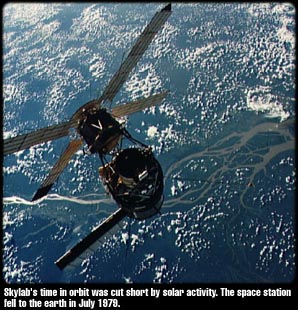|
|
|||||
|
|
|||||
| These energetic electromagnetic bombardments can also disrupt power grids and radio transmissions on earth. Both the flow of electric current in wires and the transmission of radio waves through the air can be interfered with by the energetic magnetic radiation from the sun. Often, these storms produce surges in the power grid and static on the radio, and if the waves of energetic particles are strong enough, power grids can be overloaded, and radio signals drowned out. As Dearborn says, "The particles from the sun that get a little deeper into the earth's magnetic field can get trapped in the field and oscillate back and forth between the poles, which produces the aurora that we can see and enjoy. But at the same time, they produce a lot of radio interference, which at the lower radio frequencies can be so loud that you have difficulty broadcasting." |
| Since satellites are outside of the protection of the earth's atmosphere, they are particularly vulnerable to the severe geomagnetic storms that can result from sunspot activity. According to Dearborn, "As the accelerated energetic gas particles from the sun interact with the earth's magnetic field that the earth has, and as they slide around the earth they form current sheets that satellites have to deal with. Satellites move from a region of space that has one charge to an area that has another charge, and when they cross those boundaries, the surface of the satellite can suddenly change polarity as it moves into a region where there is a different electric field. You get arcing and you get electric currents flowing inside the satellite in places where they're not supposed to flow, and that can be very bad for the satellites." |

|

|
In addition to these polarity changes which can damage sensitive electronics in satellites, the increased solar emission also causes the earth's atmosphere to "puff out." According to Fisher, this creates increased drag on orbiting satellites. This increased drag can cause satellite orbits to decay more rapidly than predicted. The 100+ ton Skylab station is a good example. Launched in 1973, the station was supposed to remain in orbit until the 1980s. The purpose of Skylab was, among other things, to study the sun. Ironically, due to increased solar activity, Skylab re-entered earth's atmosphere in 1979-- raining debris over the Indian Ocean and parts of Western Australia. |
|
|
|||||
|
|
|||||
|
|
